Top 10 Myths About Carpet
Subtitled: How some people drive us crazy with mis-information.There is a never ending barrage of scares and mis-information for the public. Mis-information like Microsoft will donate $10 for every post you make on Facebook, the tomatoes are poisonous scare, and so on and so on. Those looking for their 15 minutes of fame have not neglected to malign just about any product out there. Carpet is no exception. Some of these myths are amusing; some, serious. Enjoy.
Myth 1: I don't want (nylon/ wool/ polyester) carpet because it gets dirty.
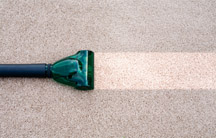 Light colors will show soil more quickly.
Light colors will show soil more quickly.The reverse form of this statement is a client will ask us which carpet will wear the best (because they have heavy traffic). After asking a few questions, we make what we believe is a suitable suggestion. Then the client chooses the white sample out of all the colors available.
If you are putting white in any area of the home except the most lightly trafficked areas, you are going to have soiling problems. The exception to this may be if you live on a white sand beach, but those are not common in our service area. Do yourself a favor, and choose a sensible color. The problem is not nylon, wool, or whatever the carpet was made from. And no, the carpet is not defective. The problem is the impractical color. And yet we have many clients that initially believe the carpet was the problem.
Myth 2: Carpet has formaldehyde in it.
 Carpet does NOT have formaldehyde.
Carpet does NOT have formaldehyde.The reason this myth is so persistent is there are companies that sell home test kits. Some of these companies are less than honest, and claim that their test kits will test your home for all sorts of nightmares including "formaldehyde from carpet". Formaldehyde does have some man-made and natural sources (plywood, for instance), but carpet is NOT one of those sources.
Myth 3: I don't want carpet because of all the chemicals.
 The EPA has tested carpet extensively and found no harmful chemicals.
The EPA has tested carpet extensively and found no harmful chemicals.I don't know why some people believe that carpet manufacturers use totally safe materials, and then blast it with a bunch of dangerous chemicals. Really, they don't. Carpet is a very simple product. There is face yarn (which is commonly wool, nylon, polyester, or polypropylene (olefin); then there is the backing material (polypropylene or jute); and then there is glue. The glue is latex based for flexibility and adheres the face yarn to the backing. Furthermore, the latex used in carpet manufacture is synthetic latex, not natural latex. Only natural latex, because it contains proteins, has been reported to cause allergic responses in some individuals.
The EPA has done extensive testing on carpet, and has not found any link between carpet and adverse health effects.
Myth 4: My carpet is soiled. It must be defective.
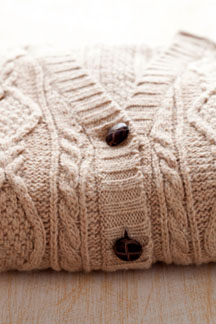 Carpet is like a sweater. Walk on it, and it will get soiled.
Carpet is like a sweater. Walk on it, and it will get soiled.Often when asked when the carpet was last cleaned, we hear that the carpet has never been cleaned. And then we are told that the carpet "shouldn't get dirty".
Carpet is made from yarn. So is a sweater. If you were to put a sweater on the floor and walk on it for a year, would it get dirty? Of course! We can expect the same from carpet. We launder our clothes. We need to clean carpets too. They are not self-cleaning.
Myth 5: Mold grows on carpet.
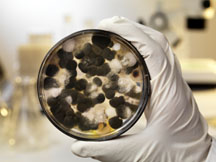 Carpet does NOT promote mold.
Carpet does NOT promote mold.What is usually missing in your home is moisture. However, a flood, leaking roof, leaking plumbing, leaking window, or excessive condensation can add moisture to your home. A high relative humidity (over 70% for extended periods), can also promote mold growth. Basements are common areas where people have moisture issues.
If you do not have walls or clothing growing mold, then carpet will not be an issue either (unless your floor is wet/damp). If you do have mold, then carpet is not the issue. Moisture is. Address the moisture immediately, and consult a mold remediation expert.
Mold is not a carpet issue. It is a moisture issue.
Myth 6: I shouldn't have carpet if I have allergies.
 Carpet traps allergens. That's good.
Carpet traps allergens. That's good.However, sweeping or vacuuming can stir up those allergens. The EPA recommends that people with asthma or allergies use a vacuum cleaner with a HEPA air filter. This special type of air filter will trap very small particles and allergens that other vacuum cleaners allow to pass through.
Carpet helps people with allergies by keeping allergens out of the air.
Myth 7: Thick carpet is better.
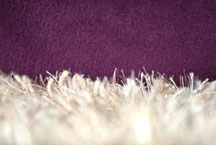 This carpet is thick, but too loose to be durable. Higher density makes a more durable carpet.
This carpet is thick, but too loose to be durable. Higher density makes a more durable carpet.Most people think carpet looks worn when it is matted down. Longer yarns (thicker carpet) allow more potential for matting. The most durable carpets we have (commercial carpets) are thin, but very dense. For your home, a happy medium can work just fine.
Because some people believe thicker carpet is better, they also believe that you have to spend a lot of money to get a good wearing carpet. But you don't have to pay a lot of money for commercial carpet, and it wears excellently. Again, a happy medium can work just fine.
Myth 8: Thicker pad is better.
Again, density and not thickness will be the most important consideration in how durable your pad is. Furthermore, for installed carpet, there are specific guidelines for pad thickness that MUST be followed. The difference in pad qualities is not thickness, but density.Myth 9: Warranties are a good way to determine which carpet is better
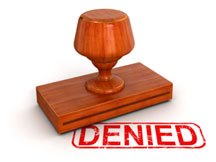 A warranty that's denied is no good. Use common sense.
A warranty that's denied is no good. Use common sense.Suffice it to say, that carpet warranties can be misleading. They often don't say what consumers believe they say. Wear warranties, stain warranties, texture retention warranties, and more give both consumers, and manufacturers a lot of trouble. You can protect yourself by learning what these warranties really cover, and by using a modicum of common sense.
The truth about carpet warranties.
Myth 10: Berber is a brand name
 A Berber man in his home. Notice the coarsely woven rugs.
A Berber man in his home. Notice the coarsely woven rugs.The Berber people are known for their particular style of rough, coarse woolen products. When carpets were first made with big bulky loops, it reminded some people of the coarse woolen products made by the Berber people. And so, berber carpet was born.
Today, we use a capitalized Berber to refer to the people, and the lowercase berber to refer to a style of carpet.